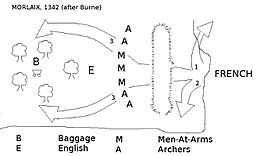Battle of Morlaix facts for kids
Quick facts for kids Battle of Morlaix |
|||||||
|---|---|---|---|---|---|---|---|
| Part of the Breton War of Succession | |||||||
 Map showing disposition of English forces during the battle. |
|||||||
|
|||||||
| Belligerents | |||||||
| House of Montfort, Brittany Kingdom of England |
House of Blois, Brittany Kingdom of France |
||||||
| Commanders and leaders | |||||||
| Earl of Northampton | |||||||
The Battle of Morlaix was a fight that happened near Morlaix, France, on September 30, 1342. It was part of a bigger conflict called the Breton War of Succession. In this battle, English and Breton forces fought against French and other Breton forces. The English side had laid siege to the town of Morlaix. However, a French relief army arrived to help the town. The English set up a strong defensive spot. After many attacks, the French made the English retreat into nearby woods. Then, the French army also pulled back.
Contents
The War for Brittany's Throne
Why the War Started
In 1341, John III, Duke of Brittany died. He didn't have any children to take his place. This caused a civil war in Brittany, which was a powerful duchy (a type of small kingdom). The war lasted about 25 years. Two main people wanted to be the ruler: John's half-brother, John of Montfort, and his niece, Joan, Duchess of Brittany. Joan was married to Charles of Blois.
Charles and Joan had a lot of support from the nobles and church leaders in Brittany. John of Montfort was less popular in Brittany itself. However, Charles of Blois was also the nephew of Philip VI of France, the King of France. This meant France supported Joan's claim. This brought outside countries into the fight. England, led by King Edward III, decided to support John de Montfort.
Helping Out at Brest
At first, King Edward III of England couldn't help John de Montfort much. He had his own problems at home. But eventually, he sent a small group of soldiers. This group was led by Sir Walter Mauny. Mauny had some early successes. Because of this, Edward decided to send a larger force. This bigger group included knights and archers. It was led by William de Bohun, 1st Earl of Northampton.
The departure of this force was delayed for a long time. By the time they reached Brittany, John de Montfort had been captured by the French and their Breton allies. So, his wife, Jeanne de Montfort, was leading the fight. When Northampton landed on August 18, 1342, Jeanne and her men were under siege. They were trapped in Brest by a large French and Breton army. This army was led by Charles of Blois. There were also ships from Genoa helping them. When Northampton's force arrived, the French and Bretons seemed to run away. They didn't even try to fight the smaller English force. This ended the siege of Brest.
English Army Moves Inland
After helping Brest, Northampton's army moved further inland. We don't have many details about this journey. But eventually, they reached Morlaix. Morlaix was one of Charles de Blois’ strongholds, meaning it was a well-defended place he controlled.
The English Siege of Morlaix
Northampton's first attack on Morlaix didn't work. His army was pushed back with some losses. So, he decided to start a siege instead. This meant surrounding the town and trying to starve out the people inside.
Meanwhile, Charles de Blois's forces had left the siege at Brest. They had been growing in numbers. They might have had as many as 15,000 soldiers. Charles learned that Northampton's army was much smaller than his own. So, Charles began to march towards Morlaix. He planned to make Northampton stop his siege.
When Northampton heard that de Blois was coming, he didn't want to be caught. He didn't want to be stuck between de Blois's army and the soldiers inside Morlaix. So, Northampton made his army march at night to meet Charles de Blois before he reached the town.
We don't have many detailed accounts of this battle. Only a few English writers from that time wrote about it. They didn't give many details about how the armies were set up. We know the French and Breton forces were in three lines. At least one of their groups was made only of mounted knights. This group was led by Geoffroi de Charny. The French and Breton army had many more soldiers than the English. The English army was smaller, even after getting some reinforcements.
What Happened in the Battle
We don't know all the exact details of the fighting. But in the end, about 50 French knights were killed. Also, 150 French soldiers were captured. This included Geoffroi de Charny. Some of the foot soldiers were also involved in the fighting.
The English army became worried about the remaining French forces. So, they pulled back into the woods behind them. In the woods, they were safe from a full cavalry charge. What was left of de Blois’s army then managed to help Morlaix. The English, who were now stuck in the woods, became the ones being besieged. They were trapped in the woods for several days.
Sources
- Sumption, Jonathan ‘The Hundred Years War Volume 1 Trial by Battle’ Faber 1992
- Burne, Lt. Col. Alfred H. ‘The Crécy War’ Greenhill 1990
- DeVriess, Kelly ‘Infantry Warfare in the Early 14th. Century’ Boydell 1996
- Ayton, A & Preston P ‘ The Battle of Crécy 1346’ Boydell 2005

